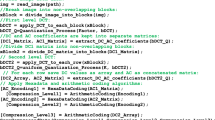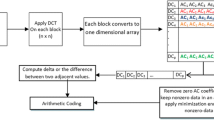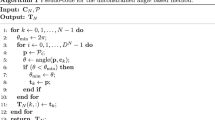Abstract
Envisioned advanced multimedia video services include arbitrarily shaped (AS) image segments as well as regular rectangular images. Image segments of the TV weather report produced by the chromo-key technique [1] and image segments produced by video analysis and image segmentation [2–4] are typical examples of AS image segments. This paper explores efficient intraframe transform coding techniques for general two-dimensional (2D) AS image segments, treating the traditional rectangular images as a special case. In particular, we focus on the transform coding of the partially defined image blocks along the boundary of the AS image segments. We recognize two different approaches — thebrute force transform coding approach and theshape-adaptive transform coding approach. The former fills the uncovered area with the optimal redundant data such that the resulting transform spectrum is compact. A simple but efficient mirror image extension technique is proposed. Once augmented into full image blocks, these boundary blocks can be processed by traditional block-based transform techniques like the popular discrete cosine transform (DCT). In the second approach, we change either the transform basis or the coefficient calculation process adaptively based on the shape of the AS image segment. We propose an efficientshape-projected problem formulation to reduce the dimension of the problem. Existing coding algorithms, such as the orthogonal transform by Gilge [5] and the iterative coding by Kaup and Aach [6], can be interpreted intuitively. We also propose a new adaptive transform based on the same principle as that used in deriving the DCT from the optimal Karhunen-Loeve transform (KLT). We analyze the tradeoff relationship between compression performance, computational complexity, and codec complexity for different coding schemes. Simulation results show that complicated algorithms (e.g., iterative, adaptive) can improve the quality by 5–10 dB at some computational or hardware cost. Alternatively, the simple mirror image extension technique improves the quality by 3–4 dB without any overheads. The contributions of this paper lie in efficient problem formulations, new transform coding techniques, and numerical tradeoff analyses.
Similar content being viewed by others
References
Sandbank CP (1990) Digital Television, John Wiley, West Sussex
Musmann HG, Hotter M, Ostermann J (1989) Object-oriented analysis-synthesis coding of images. Signal Processing: Image Commun 1:117–138
Hotter M (1990) Object-oriented analysis-synthesis coding based on moving two-dimensional objects. Signal Processing: Image Commun 2:409–428
Jain A (1989) Fundamentals of Digital Image Processing. Prentice-Hall, Englewood Cliffs, NJ
Gilge M, Engelhardt T, Mehlan R (1989) Coding of arbitrarily shaped image segments based on a generalized orthogonal transform. Signal Processing: Image Commun 1:153–180
Kaup A, Aach T (1992) A new approach towards description of arbitrarily shaped image segments. International Workshop on Intelligent Signal Processing and Communication Systems, Taipei, Taiwan, pp 543–553
Chang S-F, Messerschmitt DG (1993) A new approach to decoding and compositing motion-compensated DCT-based images. IEEE International Conference on Acoustics, Speech, and Signal Processing, pp 421–424
Porter T, Duff T (1984) Compositing digital images. Comput Graph 18:253–259
Clarke RJ (1985) Transform coding of images. Academic Press, London
CCITT Recommendation H.261 (1990) Video Codec for Audio-visual Services at px64 kbits/s
Standard Draft (1991) JPEG-9-R7
Standard Draft (1990) MPEG Video Committee Draft, MPEG 90/176 Rev. 2
Takahashi M, Chang S-F, Messerschmitt DG (1993) Joint shape representation and anti-aliasing for arbitrarily-shaped image objects. IEEE International Workshop on Intelligent Signal Processing and Communication Systems, Sendai, Japan
Soltanian-Zadeh H, Yagle AE (1993) Fast algorithms for extrapolation of discrete band-limited signals. IEEE International Conference on Acoustics, Speech, and Signal Processing, pp 591–594
Foley JD, Dam A, Feiner S, Hughes J (1990) Computer graphics: principles and practice, 2nd ed, Addison-Wesley, Reading, Mass.
Karlsson G, Vetterli M (1989) Extension of finite length signals for sub-band coding. Signal Processing 17:161–168
Golub GH, Van Loan CF (1989) Matrix Computations, 2nd edition, John Hopkins University Press, Baltimore
Author information
Authors and Affiliations
Corresponding author
Rights and permissions
About this article
Cite this article
Chang, SF., Messerschmitt, D.G. Comparison of transform coding techniques for two-dimensional arbitrarily shaped images. Multimedia Systems 1, 231–239 (1994). https://doi.org/10.1007/BF01223345
Issue Date:
DOI: https://doi.org/10.1007/BF01223345




